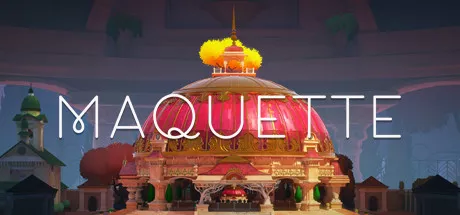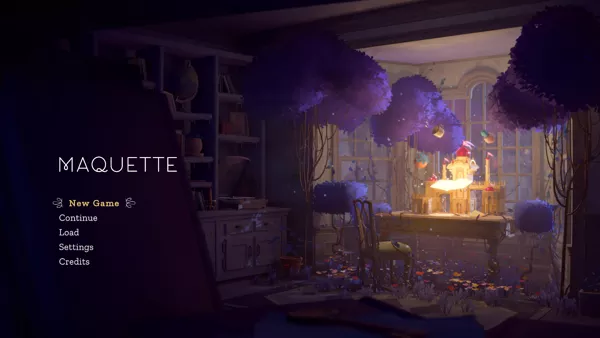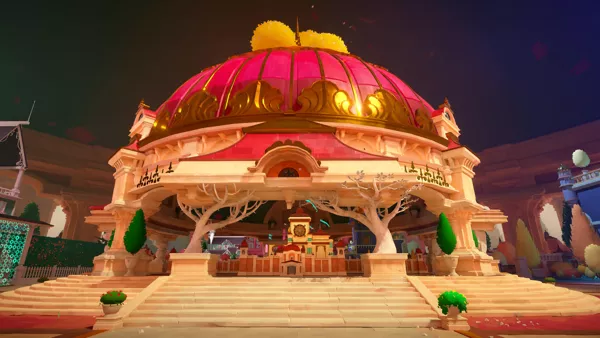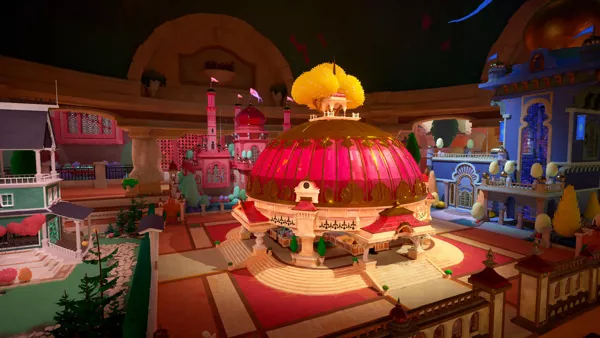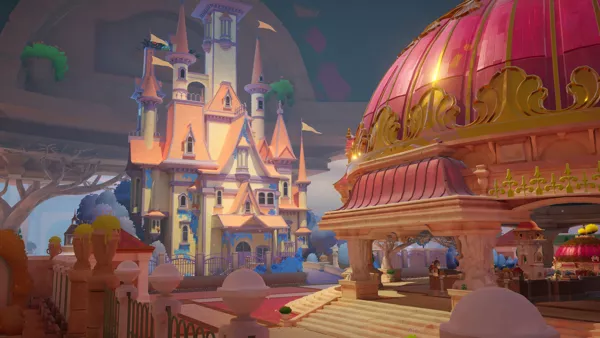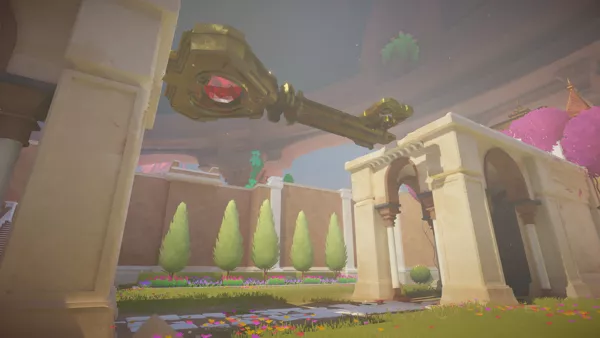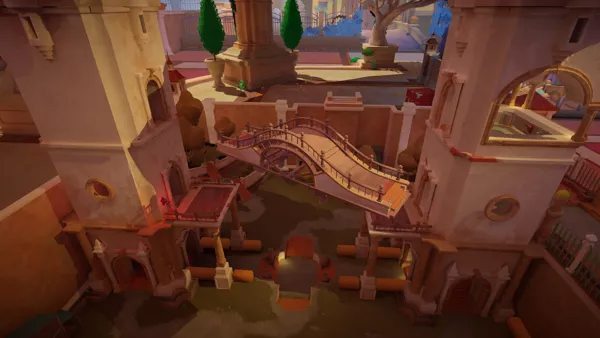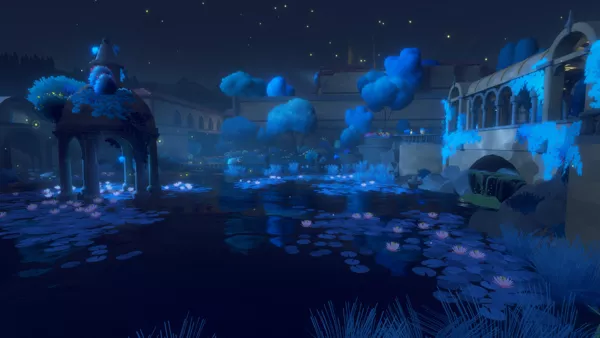Maquette
Official Description (Ad Blurb)
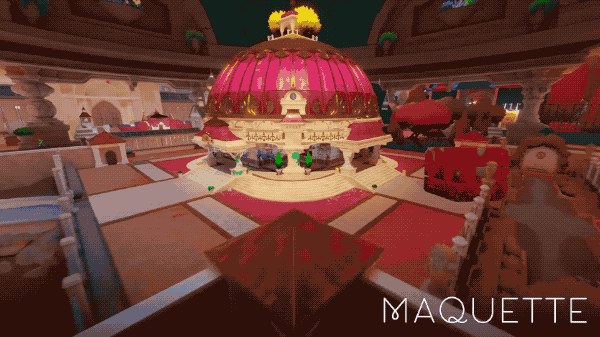
Maquette is a first-person recursive puzzle game that takes you into a world where every building, plant, and object are simultaneously tiny and staggeringly huge. Maquette makes it possible by twisting the world into itself recursively in an MC Escher-esque fashion.
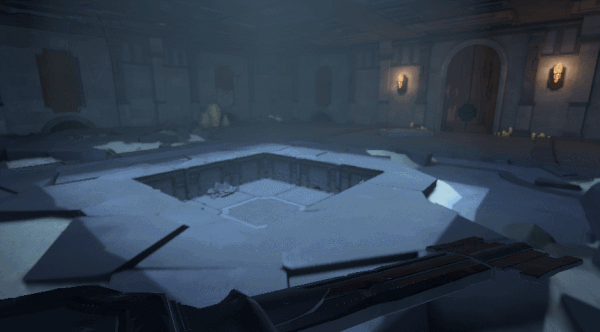
Head to the center of the world and you'll feel like a giant, towering over buildings and walls. But venture further out, and start to feel small as things get larger and larger - to the point where cracks in the ground become chasms.
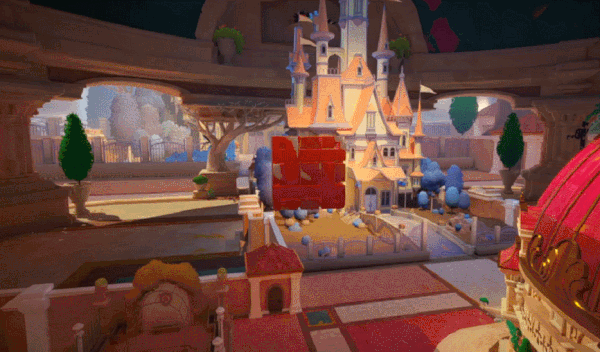
In Maquette you will explore the scales of everyday problems in a modern-day love story. Where sometimes the smallest of issues can become insurmountable obstacles.
Source: Steam Store Description
Spellings
- マケット - Japanese spelling
Groups +
Screenshots
Promos
Videos
See any errors or missing info for this game?
You can submit a correction, contribute trivia, add to a game group, add a related site or alternate title.
Credits (Windows version)
161 People (101 developers, 60 thanks) · View all
| Directed by | |
| Kenzie | |
| Michael | |
| Lead Engineer | |
| Senior Engineer | |
| Audio Director | |
| Art Director | |
| Senior Environment Artists | |
| Environment Artists | |
| Concept Artist | |
| Cutscenes Artist | |
| Lighting Artist | |
| VFX & Tech Artist | |
| Producer | |
| Story | |
| Game Design | |
| Production Baby |
|
| Environment Artists | |
| Foley Artists | |
| Foley Mixer | |
| Performance Engineer | |
| [ full credits ] | |
Reviews
Critics
Average score: 72% (based on 16 ratings)
Players
Average score: 2.7 out of 5 (based on 7 ratings with 1 reviews)
Getting better as things get worse
The Good
Maquette is the kind of game that makes me want to rate gameplay and storytelling qualities entirely independent from each other. A bittersweet modern love story wrapped around a game of spatial brainteasers in a surreal, recursive game world, I initially found the puzzle mechanics to be very clever and well realised, while the telling of the implausible love story ranged from corny to embarrassing. That impression lasted well into the second half of the game, when the writing started to improve dramatically and forced me to reevaluate my opinion.
Revolving around the ups and downs of a modern-day, long-term romantic relationship, Maquette tells a rather terrible love story, but a moving and honest story of love’s aftermath. The ironic question is whether it’s worth sitting through the cheesy and bland honeymoon phase to get to appreciate the touching breakup and post-breakup parts.
Luckily, my impression was that the quality of the puzzle elements follows a curve opposite to that of the story. Varied and motivating in the beginning, they start to grow a bit repetitive with the third or fourth key-in-door or bridge placement problem. Just as the puzzle elements start to unravel, the storytelling takes a turn for the better and picks up the slack.
Almost every puzzle in Maquette is based on the game taking place in a recursive world. At the centre is the eponymous “maquette”, a scale model of the entire environment. Conversely, when looking away from the maquette, one can see that the current environment is itself a maquette in an oversized version of itself. Even larger iterations can be made out in the distance.
When an object is dropped in the maquette, a larger, but otherwise identical version of it will appear at the same spot in the surrounding environment. Likewise, tiny models of objects located in the world can be taken back out of the maquette. Most puzzles revolve around getting the right size of the right objects to the right place. The scope is implicitly limited by the player staying the same size, while objects deep enough in levels of maquettes become too tiny to pick up, and larger versions of the game world become impassable due to towering heights and depths.
This is quite difficult, and maybe pointless, to try and put into words, but the game does a great job in conveying these mechanics intuitively. Since the differently sized versions of each object move synchronously, a key dropped in the maquette can immediately be seen, in its gargantuan version, dropping to the floor outside with a satisfying, metallic clunk. How this has been realised in the game’s 3D engine is impressive.
Maquette also takes care to always try and give stuck players some subtle clues on where to look for the next step. Important objects glimmer, mysterious noises or animations point the way, and occasionally the storyline provides a clue for the current puzzle. I was stumped twice, but in both cases had to admit that the game had given me fair clues on where to look.
As the limits of the underlying puzzle concept are increasingly pushed, so are the game world and engine. Glitches in collision detection become more frequent and sometimes force players to reload a previously saved game. The game also fails when it veers into genuine jump & run territory, where it feels imprecise, and I was never sure whether hopping across obstacles was what the game really expected of me or whether it would just lead me into a potentially glitchy dead end.
Visually, Maquette struck me as a gorgeous game right from the beginning of the prologue, if not already in the main menu. It’s kept in a lightly textured, colourful look with soft and lush lighting. From fluttering butterflies and swaying flowers, animations are subtle and effective. Cutscenes often feature colourful drawings – both protagonists are passionate sketch artists – which are animated into and out of existence. It’s a beautiful game to look at in every respect, and the restrained ambient noise helps the world feel wonderful and mysterious in a slightly dream-like style which at times reminded me of Ico.
Apart from a handful of ambient musical cues, Maquette also features several softly rocky and folky ballads by independent Bay Area artists which are played at specific points in the story. They fit the mood very well and sound good, so it’s a pity that they’re sometimes cut short if a puzzle is solved too quickly. I particularly liked how the reverb effects changed depending on which scale of the environment I was currently exploring.
Enchanting visuals and beautiful music are essential for any work that wants to tell a good love story, and I’d give Maquette full marks for both. But how do those clever, recursive, physical puzzles connect back to the story of love and heartbreak? The answer is, unfortunately: barely.
The official description draws the analogy: in long-term relationships, small problems can turn into seemingly insurmountable obstacles. With distance, things that once caused devastating and hurtful fights can seem tiny and insignificant. It’s a wonderful connection in theory, but it never materialises in the game. I enjoyed solving the puzzles, and I solved them in environments that often referenced the love story I was following. But I never felt that the two were really intertwined. I think the game as a whole could have fused better if the concrete tasks I was struggling to achieve in the puzzles had occasionally correlated with something Michael and Kenzie were struggling to achieve in their relationship.
Although the puzzles feel disconnected from the plot, I want to point out that the world’s details very much reflect it in beautiful and subtle ways. The fantastical surroundings of the early sections spring directly from Michael and Kenzie’s imaginations as they sketch out paintings and a possible future together. Those paying attention will start noticing little cracks appearing in the buildings long before the dialogue makes the relationship problems obvious. As things get worse, one might notice objects that were part of the couple’s shared life and dreams, and puzzles solved earlier, lying shattered and discarded by the wayside.
The Bad
Which brings me all the way back to this story that I initially disliked so much. Any game that wants to tell players an emotional love story needs to spend enough time building up its characters and making the relationship feel believable and like it matters. This isn’t where Maquette goes wrong, nor is it the main character’s internal monologue, told through floating, handwritten notes, which even in the first half are mostly fine. The core problem is that the dialogues between the two lovers, through which most of the story of the relationship is told, feels very corny and inauthentic. The voice acting is good, it’s the actual lines that don’t ring true with me at all. I couldn’t believe Michael and Kenzie’s honeymoon phase to be like one that a real, grown-up couple would have. It felt more like what a pre-teen imagines a grown-up relationship to be like. (If you want to avoid reading anything that could be considered a spoiler, skip the next two paragraphs).
The Bottom Line
Not even when conflict arises in the relationship do the dialogues become much more believable. It’s only when the end of the characters’ shared life is looming that the writing started resonating with me. Dialogue naturally ceases to be the major driver of the plot, and the focus turns back to the internal monologue the game opened with. It’s obvious from the very beginning that the monologue is a letter written by one of the protagonists to the other. Gradually, it becomes clear that it’s a post-breakup letter, of the kind written after having gained some emotional distance, taking stock of what was and what remains, the kind that doesn’t necessarily have to be sent to the person it’s addressed to. The letter formed by this monologue ends up with many wonderful, bittersweet, touching, even deep lines of thought. Thoughts that anyone who has ever gone through a breakup either knows first-hand or can at least empathise with.
What made me like the writing even more was the realisation – which I only came to after having read the letter a second time – that the game never mentions whether this letter is written by Michael or Kenzie. Probably due to me being male, I implicitly assumed I was playing Michael as he is writing to Kenzie. But nothing in the story contradicts the interpretation that it could be Kenzie writing to Michael, nor that whoever wrote the letter indeed sent it and we might be reading it from the eyes of the recipient. I think it’s wonderful that the story can be read in any of these ways, depending on which character the player identifies with more, and which outcome they’d like to imagine. In real life, people losing touch for good after having shared such a part of their lives feels very sad to me, so I’m personally quite fond of the thought of letters sent and received, thoughts and gratitude shared, and friendships retained.
It’s the great paradox of Maquette’s story that it can feel as if it’s been written by someone who has never had a real, long-term relationship before but has intimate and authentic experience in dealing with the end of one. As the game wrapped up, it had managed to change my opinion of it. I thought I would end up considering it a great and clever puzzle game with a very poorly told and bland story. As I approached the end of the game, it served more and more thought-provoking lines that I had to give it credit for. Having finished it, I can’t even call it a bad love story anymore. For all its weaknesses in the beginning, after it was all wrapped up, I was left with the faintly choked up feeling I get at the end of any slightly soppy romance plot worth its while.
Windows · by Daniel Saner (3515) · 2025
Analytics
Identifiers +
Contribute
Are you familiar with this game? Help document and preserve this entry in video game history! If your contribution is approved, you will earn points and be credited as a contributor.
Contributors to this Entry
Game added by Sciere.
PlayStation 5 added by Kam1Kaz3NL77. Xbox Series, PlayStation 4, Xbox One, Nintendo Switch added by Alaka.
Additional contributors: Rik Hideto.
Game added March 3, 2021. Last modified November 17, 2023.


